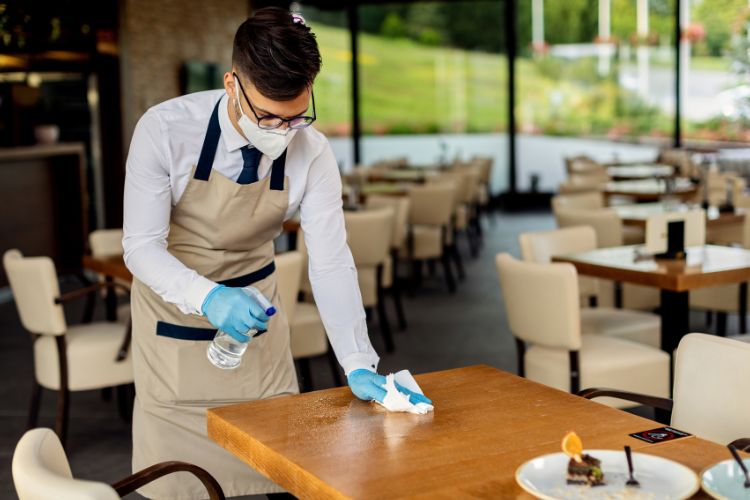Table Of Contents
- Day-One Revenue Impact Of Closures Or Avoidance Of Customers
- 1. Forced Closures And Limited Closures
- 2. Customers Lost Due To Bad Publicity And Reviews On The Internet
- Fines And Permit Fees On Failed Inspections
- 1. Health Code Fines
- 2. Follow-Up Inspection Fees
- Investments Necessary To Pass Re-Inspection
- 1. Staff Time And Products For Deep Cleaning
- 2. Buying New Equipment Or Renovating
- 3. Outsourcing Pest Control Agencies For Pest Control, Mold Remediation
- Long-Term Reputational Damage
- 1. Receptivity With Slow Pace Of Lost Customers
- 2. Long-Term Stigma Of Failure
- Steps To Rebound Financially After Failure
- 1. Advertising And Marketing To Restore Image
- 2. Legal Methods For Resisting Fines Or Closures
- The Bottom Line: Restaurants Can Recover From Failed Inspections
The Overlooked Cost Of Cleanliness In Restaurants
In restaurants, food quality and service tend to take center stage, with cleanliness as a given — something that’s merely “taken for granted” instead of being proactively managed as part of the business plan.
The reality is, though, cleanliness is one of the fundamental pillars of profitability and survival. When hygiene fails, the cost in dollars is far more than a mop and bucket.
A faulty inspection or a single viral rant griping about restaurants cleanliness and unsanitary conditions can lead to revenue loss, costly fines, and permanent damage to reputation.
To restaurant owners who already work on razor-thin profit margins, the under-the-radar expenses of poor cleanliness can be devastating.
This piece takes apart the hidden costs restaurants pay when cleanliness takes a backseat and explores the business-savvy perspective of what it costs to recover and come back better.
Day-One Revenue Impact Of Closures Or Avoidance Of Customers
Restaurants operate on slim margins, with profits typically falling somewhere between 3 and 5% of revenue. That is, each lost business day directly consumes from the bottom line. Cleanliness failures don’t just damage an image — they hit directly at revenues.
1. Forced Closures And Limited Closures
Health inspectors are able to immediately close down operations if conditions represent an immediate health threat.
This might be anything from a pest infestation to poor refrigeration. Even a “partial closure,” such as closing the kitchen but not the bar, is a significant operational disruption.
Example: A small restaurant that receives $8,000 in daily receipts and closes for a week due to an inspection failure loses $56,000 in gross revenue— not including ongoing costs like rent, payroll, and utilities.
2. Customers Lost Due To Bad Publicity And Reviews On The Internet
Bad news travels fast in the age of smartphones. Customers who spot an “F” grade posted at the entrance or read a viral review of dirty restrooms may decide to skip the restaurant altogether.
Websites like Yelp, Google, and TripAdvisor provide these instances additional support, creating a multiplier effect on lost revenues.
A National Restaurant Association survey finds that 61% of restaurant diners read online comments before eating.
When complaints about poor hygiene drive those comments, customer traffic drops through the floor — and sometimes takes months to climb back up.
Fines And Permit Fees On Failed Inspections
Revenue loss is just the beginning of a multitude of woes. Restaurants cleanliness also have to deal with regulatory financial fines that strain already strained cash flow.
1. Health Code Fines
Fines are jurisdiction-specific, but repeat offenses habitually escalate quickly. For example:
- Food storage improperly: $200–$500 fine
- Rodent infestation: $1,000 fine
- Failure to correct violations: $2,500+ fine
These aren’t one-time costs. Several infractions tally up to thousands of dollars in surprise costs — dollars that would otherwise be used on growth efforts like marketing or menu engineering.
2. Follow-Up Inspection Fees
Health departments usually must re-inspect before re-opening, and restaurants must pay for such inspections.
Fees range from $250 to $1,000 per follow-up, depending on the location. Multiple follow-ups may be needed if issues aren’t fully addressed, lengthening downtime and expenses.
Investments Necessary To Pass Re-Inspection
Fines and closures are only half of it. Restaurants have to spend a lot in compliance, often short notice, before reopening.
1. Staff Time And Products For Deep Cleaning
Deep cleaning of a dining or kitchen area requires a lot more than normal sweeping and mopping. Restaurants cleanliness often require:
- Extra staff time (with overtime pay)
- Heavy-duty cleaning chemicals and disinfectants
- Special food safety training sessions
These are direct supply and labor expenses that affect the P&L instantly.
2. Buying New Equipment Or Renovating
Occasionally the issue isn’t staff conduct but facilities. A worn-out walk-in cooler that can’t maintain temperatures, broken tile that breeds bacteria, or inadequate ventilation systems can all cause violations. Replacement and renovation work can quickly cost five or six figures.
Example: Replacing a commercial refrigerator can run $10,000–$15,000, while remodeling a kitchen to meet ventilation or flooring codes can run over $50,000.
3. Outsourcing Pest Control Agencies For Pest Control, Mold Remediation
Major offenses call for specialized contractors. Pest control agencies, mold remediation companies, or sanitation specialists not only charge high service fees but also demand regular inspections to ensure compliance.
These are non-negotiable — the cost of survival.
Long-Term Reputational Damage
The bloodletting doesn’t stop when the restaurant is reopened. In fact, the hardest cost to recover is lost trust.
1. Receptivity With Slow Pace Of Lost Customers
While once the cleanliness issues are taken care of, customers take some time to return. It has been discovered through research that once diners perceive a restaurant as dangerous, it will take a few good experiences in order to regain trust, and many never return.
If a restaurant would typically sell 300 covers per day but dips to 200 following the restart, that is a 30% long-term revenue hit until reputation is regained.
2. Long-Term Stigma Of Failure
The internet never forgets. News articles on “restaurant closed due to rats” can be searched after many years.
Competitors may capitalize on it, and would-be business collaborators or investors may not want to be linked to a brand that failed in the past.
In the case of chains or franchises, failure in one unit can damage the overall brand reputation, impacting system-wide sales.
Steps To Rebound Financially After Failure
Returning from a cleanliness failure is not just mopping floors. It entails a multi-layered financial and strategy recovery.
1. Advertising And Marketing To Restore Image
Restaurants must widely advertise their return after reopening. Some tactics are:
- Public press releases touting upgraded safety protocols
- Social media promotions highlighting behind-the-scenes cleaning procedures
- Promotions (discounts, loyalty programs) to encourage repeat customers
- Public exhibition of certifications or A+ health grades
This advertising cost may be an extra expense, but it has to be undertaken to offset negative publicity.
2. Legal Methods For Resisting Fines Or Closures
Some closures are the result of disputed findings or punitive fines. Restaurants may engage lawyers to:
- File appeals on inspection findings
- Negotiate to lower fines
- Organize payment plans for penalties
Legal costs, while another expense, can recoup tens of thousands in the long term.
The Bottom Line: Restaurants Can Recover From Failed Inspections
A failed cleanliness inspection is a disaster, but it doesn’t need to be permanent. Although the overlooked costs — from lost sales to harm to their reputation — are extreme, proactive investment in commercial cleaning services has a higher return on investment than recovery on the back end.
Restaurants that treat cleanliness as a matter of regulatory compliance rather than a core business strategy will safeguard profitability, maintain customer trust, and stand out in competitive markets.
The restaurant industry rests on trust. Customers don’t simply buy meals — they buy safety, quality, and peace of mind. And in that equation, cleanliness isn’t an expense. It’s one of the smartest investments an entrepreneur can make.
Read Also:














